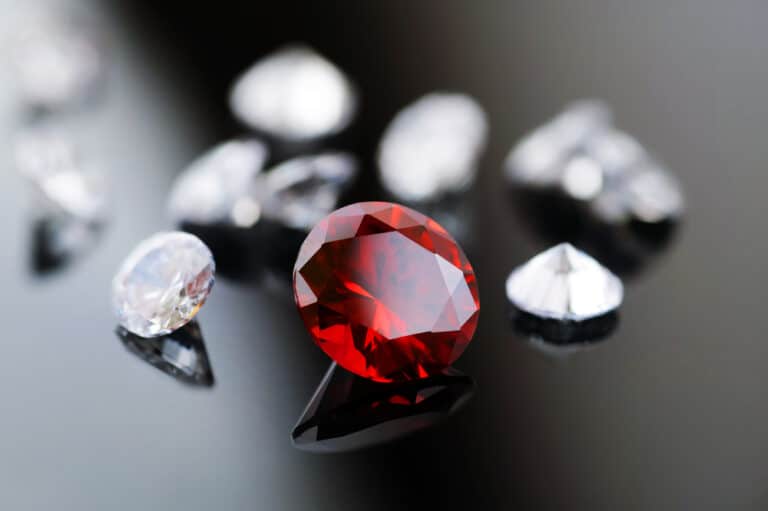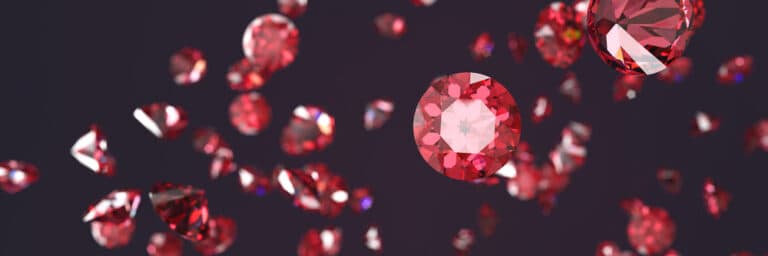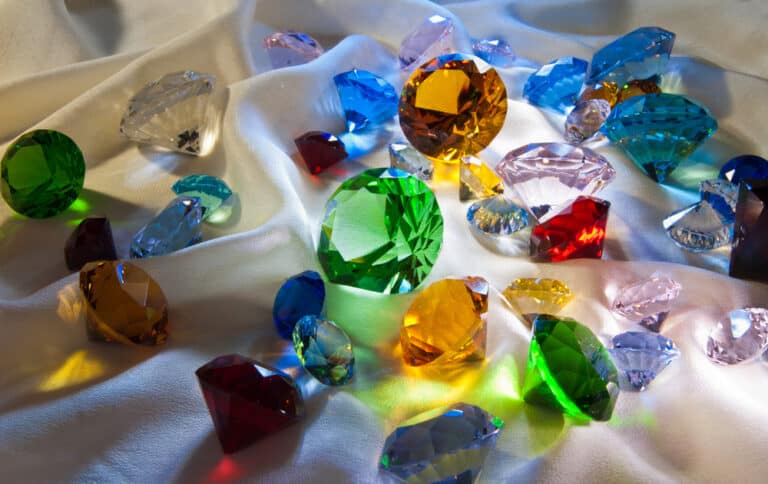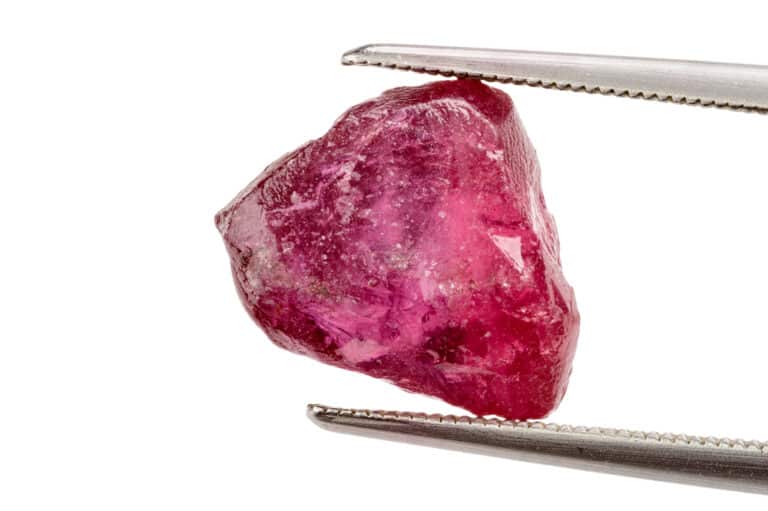Alchemists never managed to find the magic recipe for turning lead into gold. But Auguste Verneuil, a French chemist, discovered how to turn alumina into rubies in 1902, using the flame-fusion process (also known as the Verneuil process). Since then, other methods have emerged, raising synthetic rubies’ popularity and affordability. But how much are synthetic rubies worth?
Synthetic rubies, like most lab-made gems, are 30-40 percent less than their natural counterpart in size and cut. However, their resell value is negligible. The highest cost of a lab-made gem is its cut. An original and quality cut will be worth more than an amateur cut or a standard factory cut.
Millennials are changing the gem market. Once upon a time, synthetics were looked at as an option for “people who couldn’t afford the real thing.” But for many Millennials, it isn’t about money but making a sustainable, ethical, and environmental choice. To the naked eye, synthetics are equally beautiful to mined rubies. The only disadvantage to synthetics is that they are poor investments.
How Much Are Synthetic Rubies Worth?
Synthetic rubies are worth significantly less than mined rubies. Many jewelers specializing in mined and synthetic rubies sell their synthetics at 30-40% less. But if a mined ruby is of quality clarity with exceptional color, the synthetic version could be significantly less expensive, even as little as 10% of the price.
In addition, the price difference between synthetic and rubies widens as you exceed .9 carats. Natural rubies have significant jumps at 1 carat, 3, and 5 due to the increase in rarity. But synthetics don’t face the same challenges, so the price is about the amount of material and labor.
Do Synthetic Rubies Have Resell Value?
Synthetic rubies do not have much resell value. However, the metal it is set in may have some. A quality platinum band is still a quality platinum band, even if the stones in it are not naturally mined.
Synthetic rubies could also have some resell value if the piece is made by a designer with a sought-out name with a flair for originality, artistry, and quality craftsmanship. But the value is not in the stone itself. There is no rarity in a synthetic ruby.
What Is The Value Of Synthetic Ruby Jewelry?
The value of synthetic ruby jewelry is different than buying a piece with mined rubies. While not all natural stones hold their value or make a good investment, they are rare. On the other hand, synthetic gems are not difficult to produce and are common.
Thus, the price of a piece of jewelry with a synthetic ruby involves a different type of evaluation:
- What metal is the ruby set in?
- Is the design of the piece original or mass-produced in a factory?
- Is the design well done?
- Quality of the ruby’s cut
- Size of the ruby
Lastly, it’s about how much you’ll enjoy it. Many things we buy do not have a high resell value. Even practical purchases, such as cars, lose value once bought. That doesn’t make the vehicle “cheap” or a bad buy, but it is a poor investment.
Why Does Cut Matter In Synthetic Rubies?
Much of the value in a synthetic ruby is in the cut. Of course, the cut always matters in gems, whether mined or synthetic. But some broken or chipped mined gems can be salvaged by recutting and polishing it. But if that happens to a synthetic, it will probably be cheaper to get a new stone at its original size and shape, especially if it was machine-cut.
Like mined rubies, synthetic rubies are cut in two main ways: factory machine cuts that pump out classic designs found anywhere. As a result, they lack originality but can be pretty and enjoyable to wear. In addition, they are faster to make and can be produced in substantial quantiles.
However, custom cutting takes human labor. It is a specialized craft that takes hours. Thus, a synthetic ruby that is custom-cut will be more expensive.
But due to the market, there is no point in paying for a custom-cut synthetic ruby of the same design commonly put out by a factory. Unlike mined rubies, there isn’t any resell value. What you are buying in a custom cut are originality and artistry. It should be a piece you will genuinely love. It’s like getting a fabulous haircut: you can’t resell it, but you enjoy owning it.
That said, some factory-cut synthetics are terrible because the manufacturers simply don’t care. Thus, if buying factory-cut, the quality still matters. A poor-cut gem doesn’t look as pretty, even if it is lab-grown perfection, chemically speaking.

Why Are Some Synthetic Rubies So Cheap?
Synthetic rubies have a wide price range, just like natural rubies. However, sometimes a synthetic ruby is so cheap because it is fake. Thus, the stone has nothing in common with a genuine ruby other than its color. The bad fakes are glass.
What Is The Difference Between A Synthetic Ruby And A Fake?
Synthetic rubies are genuine rubies. The chemical composition between the two is the same.
However, a fake ruby is chemically different to its genuine counterpart. It could be glass, plastic, or a synthetic composition that is chemically different from a ruby. These are cheaper to produce than lab-made rubies and are inferior, especially in durability.
It’s like comparing a cubic zirconia to a diamond. Real, lab-made diamonds are as strong as those mined and chemically identical. But diamonds are much harder than cubic zirconia because they are not the same material.
Thus, a “lab-made” ruby is supposed to be chemically identical to a mined ruby. Many synthetic rubies are also “lab-made.” However, some unscrupulous sellers use the word “synthetic” to hawk (and even hock) fake rubies. Technically, the material is “synthetic,” but it is being framed as being chemically the same as a ruby when it is not.
Conclusion
Synthetic rubies do not have the same value as mined rubies, despite being the same in chemical composition. Nor is there any significant resell value in synthetic rubies. However, they are still a better-quality gem than a fake ruby. They will be more beautiful and have greater durability. Lab-made rubies should not be bought as an investment but for the joy of owning them.
References
- https://www.gemsociety.org/article/cutting-man-made-stones/
- https://www.researchgate.net/publication/273981302_Separating_Natural_and_Synthetic_Rubies_on_the_Basis_of_Trace-Element_Chemistry
- https://www.quora.com/Does-a-natural-ruby-have-a-resale-value-compared-to-a-lab-grown-one
- https://www.forbes.com/sites/kyleroderick/2022/12/14/advances-in-diamond-identification-enhance-industry-transparency-and-build-trust/?sh=bba01554c1f8
- https://www.reddit.com/r/jewelers/comments/qmwtzf/did_i_overpay_or_is_this_a_good_price_for_a_lab/
- https://www.reddit.com/r/jewelers/comments/rfqp1b/comment/hohdmv7/
- https://www.reddit.com/r/jewelry/comments/s4yt1c/is_it_true_that_lab_created_rubies_and_other/
- https://www.gia.edu/gem-synthetic
- https://www.diamonds.pro/education/rubies/
- https://www.withclarity.com/education/gemstone-education/ruby/ruby-value
- https://www.britannica.com/topic/Verneuil-process
- https://www.chemistryworld.com/opinion/verneuils-rubies/3010286.article
- https://www.businessinsider.co.za/millennials-want-cheap-ethical-diamond-engagement-rings-2018-5






